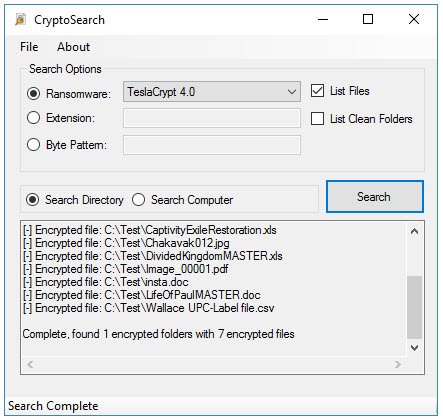It would be a difficult thing to imagine, but the first Ransomware in the history emerged in the year 1989. This Ransomware was called AIDS Trojan. The AIDS Trojan spread via floppy disks and involved sending 189 dollars to a post office box in Panama to pay the ransom. Times have now changed drastically, as cybercriminals have moved from cyber damage to cyber-crime as a business. Ransomware has, over time, emerged as the go-to malware to feed the cyber criminals who seek to cash out on their efforts.

Ransomware attacks have been growing rapidly. What does a ransomware attack mean in general? It simply means you can no longer access your system or stored files unless you pay a huge ransom or find another way to decrypt them.
Michael Gillespie, an immensely popular security researcher, has created this excellent Windows app that helps victims of ransomware infections. Let me introduce you to CryptoSearch.
CryptoSearch identifies Ransomware encrypted files
Developed by Michael Gillespie, this tool identifies the files encrypted by numerous types of ransomware families. It allows the user to copy or move the files to a new location. Again, this is done with the optimism that decrypter can recover the locked files.
CryptoSearch is not a ransomware decryptor tool or an anti-ransomware software. It is a tool which acts as a recovery and cleaning utility for Systems which have been infected with ransomware. When ransomware attacks happen, it becomes impossible for the PC user to detect all the locked files, hence the best course of action would be to move all the encrypted data to a backup drive and further wait until the experts find the solution to break the encryption.
How does CryptoSearch help
1] Automates Search Process & Movement Of Files
This tool helps the user by automating the search process and moving the files to a new location. Once this operation is completed, System owners have a backup of the infected encrypted data. CryptoSearch also helps to clean the PC by removing the infected files from the system, cleaning the hard drive, and reinstalling the Operating System.

2] CryptoSearch & ID Ransomware Work Together
CryptoSearch and ID Ransomware actually work together this means that the user needs to be online when executing this application. According to Michael Gillespie, the CryptoSearch app will query the ID Ransomware service to retrieve the required data and also to identify the type of ransomware which has made the user’s computer inaccessible.
The ID Ransomware tool recognizes all the latest ransomware types and detects their encrypted files. In other words, it doesn’t really matter which ransomware attacks your device; as long as the description of the ransomware is available in the ID Ransomware database, the user will be able to use CryptoSearch without any problems.
3] Copy, Move or Relocate Encrypted Data
CryptoSearch app uses the user’s database to search the local file System, identify the ransomware infection and further find all locked files. After this app identifies all the types of files successfully, the PC user is asked if he wants to copy or move files and then asked where to relocate encrypted data, this message is prompted via the menu. The tool is very smart as it allows the user to transfer the files by keeping the initial folder structure.
Like the other attacks, users can work to avoid ransomware. Here are some expert tips to avoid ransomware attacks and get protected against it.
- Use trusted antivirus software and firewall
- Take regular backup of your system files
- Block all Popups as these are a common tactic used by cybercriminals
- Avoid clicking on links inside emails, and visiting suspicious websites. Exercising caution is a good way to be protected
- Simply disconnect from the Internet if you receive a ransomware note. This ensures your personal data isn’t getting transmitted back to the criminals.
Conclusion
CryptoSearch is an awesome remedy for ransomware victims. Computer users have been terrorized for years now, and CryptoSearch may provide enough support, if not the complete solution. Please note that this program does not decrypt data. Offline mode support has also been added to this tool.
This tool is under development, which means that more features will soon be added to this app. You can download the CryptoSearch tool from bleepingcomputer.com.
Can you decrypt ransomware encrypted files?
Some tools may help you decrypt encrypted ransomware files on Windows 11 or Windows 10. However, in most cases, it is next to impossible to decrypt any file that is locked by ransomware. Nowadays, ransomware is more active and advanced than before, which is one reason why you may not be able to decrypt ransomware encrypted files.
How does ransomware work and spread?
Generally, ransomware comes from the internet when downloading files from untrusted sources. It encrypts your data and creates a vault to store it on your computer. Then, the attacker demands money in exchange for the decryption key. A similar process goes through everywhere, whether it is on Windows, Mac, or any other operating system.